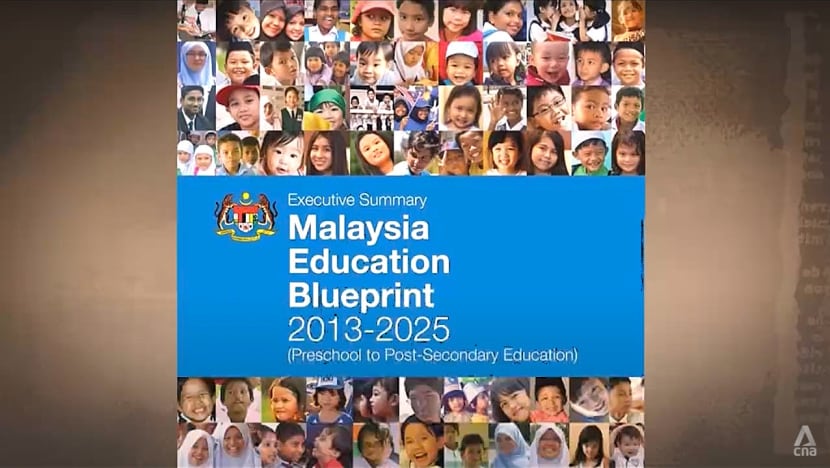Is politics behind the difficulties of Malaysia’s education reform?
Malaysian Prime Minister Anwar Ibrahim said his country cannot be “in denial” about its educational system. The programme Insight explores the complexities of language, religion and other long-standing issues that may be holding students back.


This audio is generated by an AI tool.
KUCHING/KUALA LUMPUR: Zoe Koh Qi is in her final year at one of Sarawak’s top private schools, Lodge Secondary. Here, Malay is primarily the medium of instruction for history and moral education, but other non-language subjects are taught in English.
This has benefited the 17-year-old, especially in mathematics and science. “If they were in Malay, I’d probably struggle a little bit,” she said. “Whereas now … I just have to understand the concept ’cause I don’t have problems understanding the sentences.”
Notwithstanding school fees of RM2,050 (S$630) per term in her final year — compared with free education provided by the national schools — the investment is worth it, believes her mother, Chiew Yee.
“It’s very important to learn maths and science in English because when you go (to) university … everything switches to English,” said the 44-year-old housewife.

From 2026, the state’s secondary schools, too, will begin teaching maths and science in English, it was announced this year, following on from the use of the language to teach those subjects in all its primary schools from 2020.
This was made possible by a deal between Sarawak and the federal government under the Malaysia Agreement 1963. According to the agreement, Sabah and Sarawak have some autonomy in things like educational policies.
And so Sarawak is moving ahead while the peninsula grapples with a perennial language issue. This time, with new Education Ministry guidelines on the medium of instruction for maths and science, there has been some pushback from parents and schools.
Schools in the Dual Language Programme (DLP) — introduced in 2016 to allow pupils to choose Malay or English as their medium of instruction — must now have at least one class taught maths and science in Malay.

Implementation began in March with each DLP school’s newest cohort. Previously, there were no such restrictions.
“Very frustrating,” said independent academic Sharifah Munirah Alatas, 61. “Parents are very much in favour of sticking to the policy of (teaching) at least science and mathematics in English.”
The issue arises at a time when Malaysian Prime Minister Anwar Ibrahim has called for adjustments to the educational system, with more focus needed on science, technology, engineering and maths (Stem) as well as on mastering English.
Malaysian students’ poor performance in the 2022 Programme for International Student Assessment (Pisa), which evaluates 15-year-old students on subjects like maths, science and reading, also prompted him to question why Malaysia has “failed (on) this score”.

“We must know the state of our affairs and cannot be in a state of denial,” he said in January, after the country’s results declined the most among South-East Asian countries that were tested.
For some observers, the debate about the medium of instruction for maths and science goes to the heart of the problem standing in the way of reform: the politicisation of education.
“They have to take politics out of education,” Noor Azimah Abdul Rahim, 63, the chair of the Parent Action Group for Education Malaysia, told the programme Insight.
“Ministers have to not focus too much on leaving legacies. And if there’s a good thing going, like the DLP, reinforce it.”
WATCH: How politics is behind Malaysia’s education reform difficulties (47:58)
CRITICISM OVER POLICY SHIFTS
The seeming rollback of the DLP is not the first such change in policy on the language of instruction used in schools.
In 2003, the then PM, Mahathir Mohamad, introduced the use of English for teaching maths and science, amid concerns about Malaysians’ poor standard of English.
By 2012, the then education minister, Muhyiddin Yassin, abandoned the experiment owing to a shortage of teachers qualified to teach in English. There was also concern that the dominance of English would undermine pupils’ grasp of the national language.
This was reversed with the DLP. Out of around 10,000 national schools, a quarter — largely in Sarawak — have adopted the programme. “Sarawak knows the importance of the DLP,” said Noor Azimah.
But in the peninsula and Sabah, only 8.4 per cent of primary schools offered it last year. “And in most cases, only one class,” she added. “To me, that’s a fail on the part of the ministry.”

In the Lodge Group of Schools, which includes a primary school in Kuching, teachers focus “heavily” on English, said Lodge National Secondary School principal Yunus Apok.
“We groom our kids from young, so we do have good results in our sciences and maths.”
In the past, pupils’ command of the language would have affected their understanding of the subjects if taught in English. But the language is more accessible to current students, according to Linus Lee, who has taught maths for 20 years.
“So learning mathematics in English is an easy thing for most of them,” said the Lodge Secondary schoolteacher.
But the shifts in policy nationally — which Shahnaz Al-Sadat, the chairperson of educational social enterprise LeapEd Services, described as “flip-flopping” — are “really a problem”, she said.

“We now have teachers who were taught in English but now have to teach in Bahasa Malaysia,” said the 56-year-old. “This is poor implementation.”
The repeated switching between the two languages accounts for Malaysian pupils’ poor performance, believes retired teacher Chan Seow Chee, 70, who worked at a national school for 32 years and taught maths and science.
What is therefore needed, thinks Mushtak Al-Atabi, 54, the provost and chief executive officer of Heriot-Watt University Malaysia, is to “pick one language and stick with it and see the entire generation go through that”.
But this is easier said than done, thinks veteran academic Mohd Tajuddin Mohd Rasdi. “If Anwar changes the policy of the schools from (Malay) to (English), he’ll be out of office,” said the UCSI University professor of Islamic architecture.
“I understand enough politics to know that’ll happen.”

RELIGION A HOTLY DEBATED TOPIC TOO
Besides language, another area of debate is religion. It has been reported that 16 per cent of curriculum time at primary school is dedicated to religious education, compared with maths (12 per cent), science and arts (7 per cent each).
“Yet we’re saying, ‘How is it that our students aren’t interested in Stem subjects?’ How can they be interested when there isn’t enough time for these subjects,” said Noor Azimah.
Islamic curriculum for schools was expanded in the mid-2000s. The hours devoted to religious studies including Arabic increased progressively from then on.
“This is one of the things that drives non-Muslims away from national schools. Because when the Muslims (have Islamic education), which is 11 periods a week, the non-Muslims also have to have 11 periods of moral (education),” added Noor Azimah.
“And most of the time, they don’t learn anything.”

This segregation of pupils is “very bad”, believes Munirah, the chair of the Malaysian Academic Movement.
“I’m not saying cut down and don’t teach your children religion. But what I’m saying is it’s not the responsibility of the schools. Take some of that responsibility out of the schools and put it back in the home.”
What has happened instead is the government announced plans last year to introduce a new Islamic module into public schools. The module focuses on 40 Hadiths, or sayings, of Prophet Muhammad.
Maszlee Malik, the former education minister in the first Pakatan Harapan (PH) administration, saw this as Anwar’s response to the rise of conservative culture amongst Malay-Muslims.
“The prime minister … is trying to expose Muslim students to (those) 40 Hadiths because (those) sayings … are teaching Muslims to be moderate, to be more (considerate), rather than adopting certain radical, extremist elements that’ve been taken out of context.”

Some other observers, however, believe the move is aimed at winning support from Malay-Muslim voters.
By one estimate, PH picked up only 13 per cent of Malay votes on the peninsula at the last general election, while Barisan Nasional received 32 per cent. The two coalitions form the government now.
Opposition coalition Perikatan Nasional (PN) garnered 54 per cent of the Malay votes in Peninsular Malaysia.
“My deconstruction of the situation is that Anwar is in a very difficult position right now. He’s trying his best,” said Munirah.
“But when it comes to the political will, for instance, to tackle the problem of too many religious classes in schools … it seems the administrations, all of them — not just this one, the current one — are reluctant.”

LOSING FAITH IN NATIONAL SCHOOLS?
Even with more focus on Islamic education over the years, there is an increasing trend for Malay parents to choose private schools or Chinese vernacular schools instead, another indication that national schools are failing to shine.
Already, many Chinese parents and students in Malaysia believe their vernacular schools, which use Chinese as the medium of instruction, are more academically rigorous. And they are not alone in that.
This year, Bumiputera (Malay and indigenous) pupils made up 18.52 per cent of the students in the country’s 1,301 Chinese primary schools, up from 9.5 per cent in 2010.
Idris Shahrom and his wife, Nurul Firdausi, both medical specialists, chose to enrol their children in a Chinese vernacular school for a few reasons.

“We wanted to give something like added value to our children and something new, … which is Chinese language,” he said.
Nurul added: “I see that they have better training or more homework, or they are better in mathematics.”
Their first son, Omar Ayaish Idris, was getting 100 marks in Standard Six maths last year. Now aged 13 and at a Catholic secondary school, he said he liked studying at his Chinese primary school.
“My friends didn’t make a distinction between themselves as Chinese and others,” he said in Chinese. “They also wanted to be friends with the Malays.”
Even the percentage of ethnic Indian pupils at Chinese-language primary schools has risen, from 1.67 per cent in 2010 to 2.75 per cent in 2020.
Compared with national schools, there is a perception that Chinese vernacular schools have better facilities.

“Some (national schools) are so dilapidated. You walk into a Chinese school, you think you’re walking into an international school because Chinese parents are willing to pay for education,” said Noor Azimah.
Bumiputera enrolment in international schools themselves has increased, by 49.4 per cent between 2019 and this year, education minister Fadhlina Sidek said in a parliamentary written reply in July. Non-Bumiputera enrolment in international schools increased by 30.6 per cent.
TEACHERS ‘NOT AS GOOD AS THEY THINK’
Insight producers reached out to various officials from Malaysia’s Education Ministry over a month, but they did not provide comments by the time the episode aired.
Politics is not the only reason, however, for Malaysia’s educational underperformance in Pisa or for the difficulty of educational reform.
According to Bending Bamboo Shoots, a World Bank report on education released this year, Malaysia is lacking in teacher preparedness and effective performance-tracking systems.
“One of the recommendations … was that teacher evaluations should be benchmarked (against) international standards,” said Noor Azimah, who once sat on the National Education Advisory Council. “When you don’t do that, teachers rate themselves very highly.
“But when you get the inspectors to rate teachers, the results are the reverse. They’re not as good as they think.”
Although the Malaysia Education Blueprint launched in 2013 suggested ways to improve teaching quality, for example recruiting teachers only from the top 30 per cent of graduates, implementation has been poor, said Shahnaz.

Her organisation, LeapEd Services, helps schools to adopt effective teaching practices. Teachers should have already been taught, among other things, how to “get students to be participative” and to make lessons more fun, she said.
“But if you go to classrooms, they don’t do any of that, so there’s a wide gap between what we think is being done and what’s actually being done.”
The blueprint also outlined plans for competency and performance-based career progression. But Noor Azimah said: “(Teachers) probably are given targets to meet and the support. But if you don’t meet the targets, we just continue.”
Teacher discipline has been another problem, from as far back as 2009, when an Organisation for Economic Co-Operation and Development survey indicated that one in five Malaysian school principals had reported teacher absenteeism.

Lee Chean Chung, the communications director of Parti Keadilan Rakyat in Malaysia’s coalition government, described the situation as “ridiculous”.
“In other countries, those teachers would’ve been sacked a long time ago. But we’re living (and) grappling with this issue and … still finding solutions,” he said.
Munirah attributes the problem to Malaysia’s “civil service mentality that you’re guaranteed your promotion whether or not you put in quality work”.
Teachers were put on notice, however, when Anwar warned in July that negligent, undisciplined and underperforming teachers would not automatically receive grade promotions under the time-based system.
But at the same time, surveys of teachers have found that they are burdened with administrative and non-teaching duties.
The “motivational gap” that exists is not specific to Malaysia, believes Mushtak.

“People generally aren’t motivated to do the difficult things, to learn things and work hard. … We need quality teachers who bring these subjects to life and to bring (out) the interest in students,” he said.
“We need to also support them to articulate and find their sense of purpose. Because how can they help our kids find their purpose if they themselves aren’t sure why they’re doing what they’re doing.”
EFFORTS TO UPLIFT MALAYSIA’S CHILDREN
Some other observers are alarmed by the abolition of the Primary School Achievement Test, a national examination that was taken at the end of primary school.
It was abolished in 2021 by the then PN government and was replaced with school-based and classroom assessments.

“They did that abruptly … without preparing an adequate ecosystem that’d allow students’ quality not to be compromised and teachers’ focus not to be jeopardised,” said Maszlee, 49. “It’s very unfortunate.”
In Sarawak, the state authority plans to reinstate standardised assessments at the end of primary school from next year. This will be for English as well as maths and science as part of the DLP.
This, after pupils have lost interest “and even motivation because they know there’s no exam”, said Angie Garet, 64, an educational activist and the president of the Sarawak Women for Women Society.
The Education Ministry, meanwhile, is in the middle of its latest education reform, with a new curriculum to be implemented in 2027. There will be “more emphasis on Stem education”, said Lee, citing remarks by the minister.

But a “cultural shift” is needed in society, he added. The second challenge is the implementation, which will require “commitment from the mid-level management or bureaucrats”.
The stakes are high for Malaysia. It wants to achieve high-tech status by 2030 and become a regional powerhouse in the information and communications technology industry. It has secured multibillion-dollar investments from the likes of chip giants Intel and Infineon.
But the country is facing a shortage of 30,000 engineers, Anwar warned repeatedly this year.
While the target has always been to have 60 per cent of students in science streams and 40 per cent in the arts, “no matter what we do, we seem to be stagnant”, said Noor Azimah.
We want our children to be ready for those jobs. What’s the use of having all these investments when employees are brought in from investor countries, and we’re not benefiting?”
In 2012, Malaysia’s Stem education enrolment was at 48.15 per cent; this year, it’s at 50.83 per cent. The figures include technical education and vocational training.
Another target the government is striving to attain is pre-school enrolment of 90 per cent. It is around 80 per cent now.
According to the World Bank, almost a quarter of Malaysian children entering primary school lack school readiness skills. More than four in 10 fail to achieve reading proficiency when they finish Standard Five, or Primary Five.
The reading performance is worse among the poorest families (bottom 20 per cent). Six in 10 of their children fall below proficiency levels. So the World Bank recommends improving pre-school education as part of the reforms.
There were around 2.35 million Malaysians below five years of age last year. While there are more than 16,700 government-established pre-schools and more than 9,100 private ones, this is not enough to meet the children’s needs, experts have said.

So the Education Ministry is looking to expand the number of pre-schools, with all Teacher Education Institutes, vocational colleges and secondary schools to provide pre-school premises.
The process of educational reform will require five to 10 years, at a minimum, to produce results, Lee acknowledged.
“Because (in) education … the lagging effect will be there,” he said. “So it’s important, again, to have a continuation of the policy (and) not flip-flop easily.”
Malaysia’s Pisa scores may be the spark the country needs, now that it is in the bottom third of the rankings, down from the middle third and that much further from its target of making the top third.

“This is an opportunity. I think we’ve looked at the data, we’ve acknowledged where we are. Now it’s time for us to come up with some clear policy direction and stick with it,” said Mushtak.
“The key thing is, this is a marathon, not a sprint. And I think changing policy halfway through won’t help.”
Watch this episode of Insight here. The programme airs on Thursdays at 9 p.m.


















